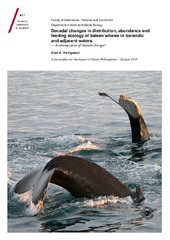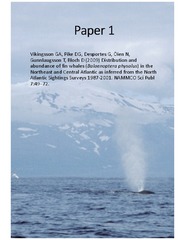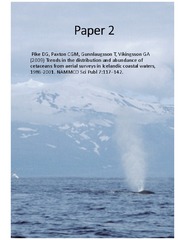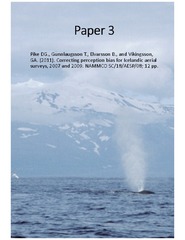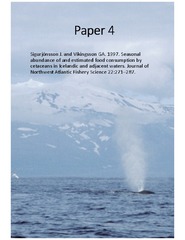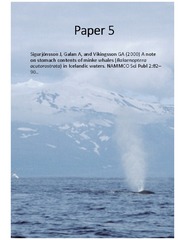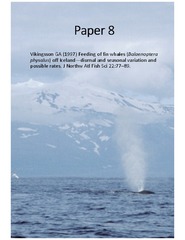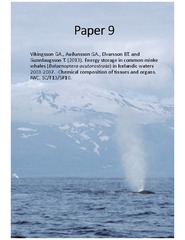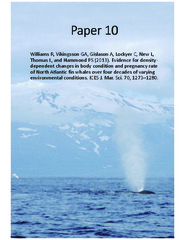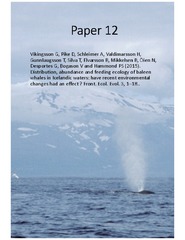| dc.contributor.advisor | Ikke relevant - dr.philos | |
| dc.contributor.author | Víkingsson, Gísli Arnór | |
| dc.date.accessioned | 2016-02-29T11:47:03Z | |
| dc.date.available | 2016-02-29T11:47:03Z | |
| dc.date.issued | 2016-01-15 | |
| dc.description.abstract | Five species of baleen whales are regularly encountered at their feeding grounds in Icelandic waters during summer. Systematic monitoring of distribution and abundance of cetaceans in Icelandic and adjacent waters was initiated in 1987 as a part of the North Atlantic Sightings Surveys (NASS). In this thesis, the objecive is to summarize the results of these surveys in relation to changes in the marine environment and the feeding ecology of four baleen whale species.
The results presented here demonstrate an important role played by baleen whales in the marine ecosystem around Iceland. Icelandic waters represent summer feeding grounds for these migratory species, which are believed to fast or feed at much lower rates during winter. Deposition of energy reserves during the feeding season differed among reproductive classes and was highest in pregnant females in both fin and minke whales. Two independent methods to estimate daily feeding rates of fin whales gave similar results. The annual food consumption by the 12 species of cetaceans regularly occurring in Icelandic waters was estimated at around 6 million tons with around two thirds attributable to fin and minke whales.
Satellite tracking experiments gave first indications of migration route and winter destinations of North Atlantic minke whales and suggested a later departure from the feeding grounds in autumn than generally assumed.
A a two stage modelling approach indicates that per-capita prey abundance affects body condition of fin whales which in turn affects fecundity. These results are consistent with a density dependent response in pregnancy rate.
Pronounced oceanographic changes in Icelandic waters since the mid-1990s, appear to have caused a northward shift in the distribution of several fish species, a decrease in krill abundance and a collapse in the sand eel population off southern and western Iceland. Concurrently, appreciable changes have occurred in distribution and abundance of several cetacean species. These include a pronounced decrease in the abundance of minke whales in the Icelandic shelf area since 2001, increase in fin whale abundance in the Irminger Sea and large increase in humpback whale abundance in recent decades. Some of these changes appear to be related to the observed oceanographic and biological changes, while others are harder to explain.
The decrease in minke whale abundance in the Icelandic continental shelf area after 2001 seems to be related to the decrease in the abundance of important prey species, sand eel and capelin. Apparently, minke whales have responded to these environmental changes by 1) a shift in distribution away from Icelandic coastal waters and 2) a change in diet of the animals remaining in Icelandic waters from sand eel, euphausiids and capelin, to herring and gadoids.
Concurrently with increasing sea temperature in the deep waters of the Irminger Sea, the distribution of fin whales expanded into this area, possibly due to an increase in the fin whale’s dominant prey species, euphausiids.
In recent decades, humpback whale abundance has increased dramatically in Icelandic waters. It is hard to relate this increase to any particular biological changes in the marine environment.
An apparent northward shift in distribution of blue whales may be related to the decrease in euphausiid abundance in the waters south and southwest of Iceland.
The research presented in this thesis indicates that effects of warming on cetacean distribution and abundance are already evident in Icelandic and adjacent waters. The NASS series has revealed appreciable changes in distribution of several cetacean species and studies into feeding ecology and energetics provide possible explanations for these changes. Potential benefits of global warming to subarctic and/or migratory species through increased size of suitable habitat might be offset by increased competition from the south.
Continued monitoring of the distribution and abundance of cetaceans as well as further studies into their feeding ecology are essential for better understanding of the recent and ongoing changes documented here. | en_US |
| dc.description.doctoraltype | dr.philos. | en_US |
| dc.description.popularabstract | Avhandlingen beskriver observerte endringer i utbredelse og bestandsstørrelse av bardehvaler i islandske og nærliggende farvann i perioden fra 1987, da systematisk overvåking ble startet.. Observerte endringer blir forsøkt satt i sammenheng med andre endringer i økosystemet (oseanografiske og biologiske), samt med hvalenes beitevaner og energibehov. De siste 20 årene er det skjedd store endringer i farvannene omkring Island. Økte sjøtemperaturer ser ut til å ha medført forskyvning nordover i utbredelse av flere fiskarter, reduksjon i mengde av krill og kollaps i tobisbestanden. Parallellt med dette er det registrert betydelige endringer i hvalbestandene, bl.a. nordlig forskyvning i utbredelse av blåhval, stor vekst i knølhvalbestanden, økning i utbredelse og antall av finhval i Irmingerhavet (sør av Island) og stor reduksjon i antall vågehval i de kystnære områder rundt Island. Årsaken til disse endringer i hvalbestandene kan mest sannsynlig knyttes til observerte endringer i tilgjengelihet af vigtige byttedyr. Resultater presentert i denne avhandlingen tyder på at klimadrevne endringer allerede er begynt å påvirke bestandene av store bardehvaler rundt Island. | en_US |
| dc.description.sponsorship | Marine Research Institute Reykjavík, The Icelandic Centre for Research, The Nordic Council of Ministers, The Norwegian Research Council, North Atlantic Marine Mammal Commission | en_US |
| dc.description | Paper VI, VII and XI of this thesis are not available in Munin.<br>Paper VI. Recent changes in the diet composition of common minke whales (Balaenoptera acutorostrata) in Icelandic waters. – A consequence of climate change? Víkingsson GA et al. Available in <a href=http://dx.doi.org/10.1080/17451000.2013.793812>Marine Biology Research, 2014, vol. 10, No. 2, 138_152</a><br>Paper VII. Body condition of fin whales during summer off Iceland. Víkingsson, GA. (1995). Available in <a href=http://dx.doi.org/10.1016/S0163-6995(06)80037-5>Whales, seals, fish and man. Blix, AS, Walløe L. and Ulltang Ø (eds). (Developments in Marine Biology, vol. 4). Elsevier, 2015. ISBN: 978-0-444-82070-9</a><br>Paper XI. First indications of autumn migration routes and destination of common minke whales tracked by satellite in the North Atlantic during 2001–2011. Víkingsson GA and Heide-Jørgensen MP. Available in <a href=http://dx.doi.org/10.1111/mms.12144>Marine Mammal Science, 31(1):376–385 (2015)</a> | en_US |
| dc.identifier.isbn | 978-82-8266-108-9 | |
| dc.identifier.uri | https://hdl.handle.net/10037/8581 | |
| dc.identifier.urn | URN:NBN:no-uit_munin_8149 | |
| dc.language.iso | eng | en_US |
| dc.publisher | UiT The Arctic University of Norway | en_US |
| dc.publisher | UiT Norges arktiske universitet | en_US |
| dc.rights.accessRights | openAccess | |
| dc.rights.holder | Copyright 2016 The Author(s) | |
| dc.rights.uri | https://creativecommons.org/licenses/by-nc-sa/3.0 | en_US |
| dc.rights | Attribution-NonCommercial-ShareAlike 3.0 Unported (CC BY-NC-SA 3.0) | en_US |
| dc.subject | VDP::Matematikk og Naturvitenskap: 400::Zoologiske og botaniske fag: 480::Økologi: 488 | en_US |
| dc.subject | VDP::Mathematics and natural science: 400::Zoology and botany: 480::Ecology: 488 | en_US |
| dc.subject | VDP::Matematikk og Naturvitenskap: 400::Zoologiske og botaniske fag: 480::Marinbiologi: 497 | en_US |
| dc.subject | VDP::Mathematics and natural science: 400::Zoology and botany: 480::Marine biology: 497 | en_US |
| dc.title | Decadal changes in distribution, abundance and feeding ecology of baleen whales in Icelandic
and adjacent waters. A consequence of climate change? | en_US |
| dc.type | Doctoral thesis | en_US |
| dc.type | Doktorgradsavhandling | en_US |


 English
English norsk
norsk